Yamaha P-125 User Manual

D I G I T A L P I A N O
P I A N O N U M É R I Q U E
P I A N O D I G I T A L
P - 1 2 5
Owner’s Manual
Mode d'emploi
Manual de instrucciones
Before using the instrument, be sure to read “PRECAUTIONS” on pages 5 – 6.
Avant d’utiliser l’instrument, lisez attentivement la section « PRÉCAUTIONS D’USAGE » aux pages 5 et 6. Antes de utilizar el instrumento, lea las “PRECAUCIONES”, en las páginas 5 – 6.
Español Français English
EN
FR
ES

For P-125
SPECIAL MESSAGE SECTION
This product utilizes batteries or an external power supply (adapter). DO NOT connect this product to any power supply or adapter other than one described in the manual, on the name plate, or specifically recommended by Yamaha.
WARNING: Do not place this product in a position where anyone could walk on, trip over, or roll anything over power or connecting cords of any kind. The use of an extension cord is not recommended! If you must use an extension cord, the minimum wire size for a 25’ cord (or less ) is 18 AWG. NOTE: The smaller the AWG number, the larger the current handling capacity. For longer extension cords, consult a local electrician.
This product should be used only with the components supplied or; a cart, rack, or stand that is recommended by Yamaha. If a cart, etc., is used, please observe all safety markings and instructions that accompany the accessory product.
SPECIFICATIONS SUBJECT TO CHANGE:
The information contained in this manual is believed to be correct at the time of printing. However, Yamaha reserves the right to change or modify any of the specifications without notice or obligation to update existing units.
This product, either alone or in combination with an amplifier and headphones or speaker/s, may be capable of producing sound levels that could cause permanent hearing loss. DO NOT operate for long periods of time at a high volume level or at a level that is uncomfortable. If you experience any hearing loss or ringing in the ears, you should consult an audiologist.
IMPORTANT: The louder the sound, the shorter the time period before damage occurs.
Some Yamaha products may have benches and / or accessory mounting fixtures that are either supplied with the product or as optional accessories. Some of these items are designed to be dealer assembled or installed. Please make sure that benches are stable and any optional fixtures (where applicable) are well secured BEFORE using.
Benches supplied by Yamaha are designed for seating only. No other uses are recommended.
Battery Notice:
This product MAY contain a small non-rechargeable battery which (if applicable) is soldered in place. The average life span of this type of battery is approximately five years. When replacement becomes necessary, contact a qualified service representative to perform the replacement.
This product may also use “household” type batteries. Some of these may be rechargeable. Make sure that the battery being charged is a rechargeable type and that the charger is intended for the battery being charged.
When installing batteries, never mix old batteries with new ones, and never mix different types of batteries. Batteries MUST be installed correctly. Mismatches or incorrect installation may result in overheating and battery case rupture.
Warning:
Do not attempt to disassemble, or incinerate any battery. Keep all batteries away from children. Dispose of used batteries promptly and as regulated by the laws in your area. Note: Check with any retailer of household type batteries in your area for battery disposal information.
Disposal Notice:
Should this product become damaged beyond repair, or for some reason its useful life is considered to be at an end, please observe all local, state, and federal regulations that relate to the disposal of products that contain lead, batteries, plastics, etc. If your dealer is unable to assist you, please contact Yamaha directly.
NAME PLATE LOCATION:
The name plate is located on the bottom of the product. The model number, serial number, power requirements, etc., are located on this plate. You should record the model number, serial number, and the date of purchase in the spaces provided below and retain this manual as a permanent record of your purchase.
Model
NOTICE:
Service charges incurred due to a lack of knowledge relating to how a function or effect works (when the unit is operating as designed) are not covered by the manufacturer’s warranty, and are therefore the owners responsibility. Please study this manual carefully and consult your dealer before requesting service.
ENVIRONMENTAL ISSUES:
Serial No.
Purchase Date
Yamaha strives to produce products that are both user safe and environmentally friendly. We sincerely believe that our products and the production methods used to produce them, meet these goals. In keeping with both the letter and the spirit of the law, we want you to be aware of the following:
PLEASE KEEP THIS MANUAL
92-BP (bottom)
COMPLIANCE INFORMATION STATEMENT (DECLARATION OF CONFORMITY PROCEDURE)
Responsible Party : Yamaha Corporation of America
Address : 6600 Orangethorpe Ave., Buena Park, Calif. 90620
Telephone : 714-522-9011
Type of Equipment : Digital Piano
Model Name : P-125
This device complies with Part 15 of the FCC Rules.
Operation is subject to the following two conditions:
1)this device may not cause harmful interference, and
2)this device must accept any interference received including interference that may cause undesired operation.
See user manual instructions if interference to radio reception is suspected.
* This applies only to products distributed by |
(FCC DoC) |
YAMAHA CORPORATION OF AMERICA. |
|
2

For AC adaptor and P-125
|
FCC INFORMATION (U.S.A.) |
||
1. |
IMPORTANT NOTICE: DO NOT MODIFY THIS UNIT! |
that interference will not occur in all installations. If this product |
|
|
This product, when installed as indicated in the instructions |
is found to be the source of interference, which can be deter- |
|
|
contained in this manual, meets FCC requirements. Modifica- |
mined by turning the unit “OFF” and “ON”, please try to elimi- |
|
|
tions not expressly approved by Yamaha may void your author- |
nate the problem by using one of the following measures: |
|
|
ity, granted by the FCC, to use the product. |
Relocate either this product or the device that is being affected |
|
2. |
IMPORTANT: When connecting this product to accessories |
by the interference. |
|
|
and/or another product use only high quality shielded cables. |
Utilize power outlets that are on different branch (circuit breaker |
|
|
Cable/s supplied with this product MUST be used. Follow all |
or fuse) circuits or install AC line filter/s. |
|
|
installation instructions. Failure to follow instructions could void |
In the case of radio or TV interference, relocate/reorient the |
|
|
your FCC authorization to use this product in the USA. |
||
|
antenna. If the antenna lead-in is 300 ohm ribbon lead, change |
||
3. |
NOTE: This product has been tested and found to comply with |
||
the lead-in to co-axial type cable. |
|||
|
the requirements listed in FCC Regulations, Part 15 for Class |
If these corrective measures do not produce satisfactory |
|
|
“B” digital devices. Compliance with these requirements pro- |
||
|
results, please contact the local retailer authorized to distribute |
||
|
vides a reasonable level of assurance that your use of this |
||
|
this type of product. If you can not locate the appropriate |
||
|
product in a residential environment will not result in harmful |
||
|
retailer, please contact Yamaha Corporation of America, Elec- |
||
|
interference with other electronic devices. This equipment gen- |
||
|
tronic Service Division, 6600 Orangethorpe Ave, Buena Park, |
||
|
erates/uses radio frequencies and, if not installed and used |
||
|
CA90620 |
||
|
according to the instructions found in the users manual, may |
||
|
The above statements apply ONLY to those products distrib- |
||
|
cause interference harmful to the operation of other electronic |
||
|
uted by Yamaha Corporation of America or its subsidiaries. |
||
|
devices. Compliance with FCC regulations does not guarantee |
||
|
|
||
|
|
||
* This applies only to products distributed by YAMAHA CORPORATION OF AMERICA. |
(class B) |
||
3
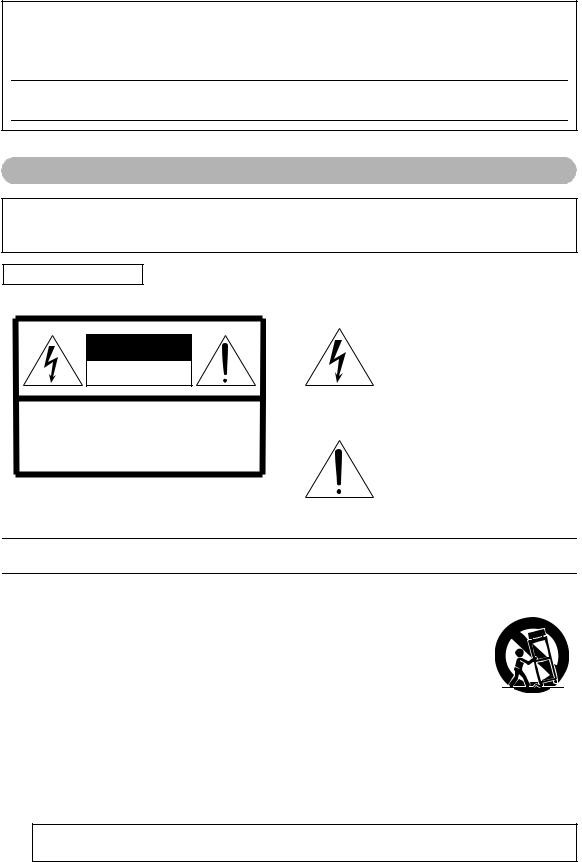
The model number, serial number, power requirements, etc., may be found on or near the name plate, which is at the bottom of the unit. You should note this serial number in the space provided below and retain this manual as a permanent record of your purchase to aid identification in the event of theft.
Model No.
Serial No.
(bottom_en_01)
For AC adaptor
This device complies with Part 15 of the FCC Rules. Operation is subject to the following two conditions:
(1) this device may not cause harmful interference, and (2) this device must accept any interference received, including interference that may cause undesired operation.
CAN ICES-3 (B)/NMB-3(B)
(can_b_02)
CAUTION
RISK OF ELECTRIC SHOCK
DO NOT OPEN
CAUTION: TO REDUCE THE RISK OF
ELECTRIC SHOCK, DO NOT REMOVE
COVER (OR BACK). NO USER-SERVICEABLE
PARTS INSIDE. REFER SERVICING TO
QUALIFIED SERVICE PERSONNEL.
The above warning is located on the bottom of the unit.
Explanation of Graphical Symbols
The lightning flash with arrowhead symbol within an equilateral triangle is intended to alert the user to the presence of uninsulated “dangerous voltage” within the product’s enclosure that may be of sufficient magnitude to constitute a risk of electric shock to persons.
The exclamation point within an equilateral triangle is intended to alert the user to the presence of important operating and maintenance (servicing) instructions in the literature accompanying the product.
IMPORTANT SAFETY INSTRUCTIONS
1Read these instructions.
2Keep these instructions.
3Heed all warnings.
4Follow all instructions.
5Do not use this apparatus near water.
6Clean only with dry cloth.
7Do not block any ventilation openings. Install in accordance with the manufacturer’s instructions.
8Do not install near any heat sources such as radiators, heat registers, stoves, or other apparatus (including amplifiers) that produce heat.
9Do not defeat the safety purpose of the polarized or grounding-type plug. A polarized plug has two blades with one wider than the other. A grounding type plug has two blades and a third grounding prong. The wide blade or the third prong are provided for your safety. If the provided plug does not fit into your outlet, consult an electrician for replacement of the obsolete outlet.
10Protect the power cord from being walked on or pinched particularly at plugs, convenience receptacles, and the point where they exit from the apparatus.
11Only use attachments/accessories specified by the manufacturer.
12Use only with the cart, stand, tri-
pod, bracket, or table specified by
the manufacturer, or sold with the apparatus. When a cart is used,
use caution when moving the cart/apparatus combination to
avoid injury from tip-over. 13 Unplug this apparatus during
lightning storms or when unused for long periods of time.
14Refer all servicing to qualified service personnel. Servicing is required when the apparatus has been damaged in any way, such as power-supply cord or plug is damaged, liquid has been spilled or objects have fallen into the apparatus, the apparatus has been exposed to rain or moisture, does not operate normally, or has been dropped.
WARNING
TO REDUCE THE RISK OF FIRE OR ELECTRIC SHOCK, DO NOT EXPOSE THIS APPARATUS TO RAIN OR MOISTURE.
(UL60065_03)
4 P-125 Owner’s Manual

PRECAUTIONS
PLEASE READ CAREFULLY BEFORE PROCEEDING
Please keep this manual in a safe and handy place for future reference.
For AC adaptor
 WARNING
WARNING
•This AC adaptor is designed for use with only Yamaha electronic instruments. Do not use for any other purpose.
•Indoor use only. Do not use in any wet environments.
 CAUTION
CAUTION
•When setting up, make sure that the AC outlet is easily accessible. If some trouble or malfunction occurs, immediately turn off the power switch of the instrument and disconnect the AC adaptor from the outlet. When the AC adaptor is connected to the AC outlet, keep in mind that electricity is flowing at the minimum level, even if the power switch is turned off. When you are not using the instrument for a long time, make sure to unplug the power cord from the wall AC outlet.
For P-125
 WARNING
WARNING
Always follow the basic precautions listed below to avoid the possibility of serious injury or even death from electrical shock, short-circuiting, damages, fire or other hazards. These precautions include, but are not limited to, the following:
Power supply/AC adaptor |
|
Fire warning |
•Do not place the power cord near heat sources such as heaters or radiators. Also, do not excessively bend or otherwise damage the cord, or place heavy objects on it.
•Only use the voltage specified as correct for the instrument. The required voltage is printed on the name plate of the instrument.
•Use the specified adaptor (page 25) only. Using the wrong adaptor can result in damage to the instrument or overheating.
•Check the electric plug periodically and remove any dirt or dust which may have accumulated on it.
Do not open
•This instrument contains no user-serviceable parts. Do not open the instrument or attempt to disassemble or modify the internal components in any way. If it should appear to be malfunctioning, discontinue use immediately and have it inspected by qualified Yamaha service personnel.
•Do not put burning items, such as candles, on the unit. A burning item may fall over and cause a fire.
If you notice any abnormality
•When one of the following problems occur, immediately turn off the power switch and disconnect the electric plug from the outlet. Then have the device inspected by Yamaha service personnel.
-The power cord or plug becomes frayed or damaged.
-It emits unusual smells or smoke.
-Some object has been dropped into the instrument.
-There is a sudden loss of sound during use of the instrument.
Water warning
•Do not expose the instrument to rain, use it near water or in damp or wet conditions, or place on it any containers (such as vases, bottles or glasses) containing liquids which might spill into any openings. If any liquid such as water seeps into the instrument, turn off the power immediately and unplug the power cord from the AC outlet. Then have the instrument inspected by qualified Yamaha service personnel.
•Never insert or remove an electric plug with wet hands.
DMI-5 1/2
P-125 Owner’s Manual 5
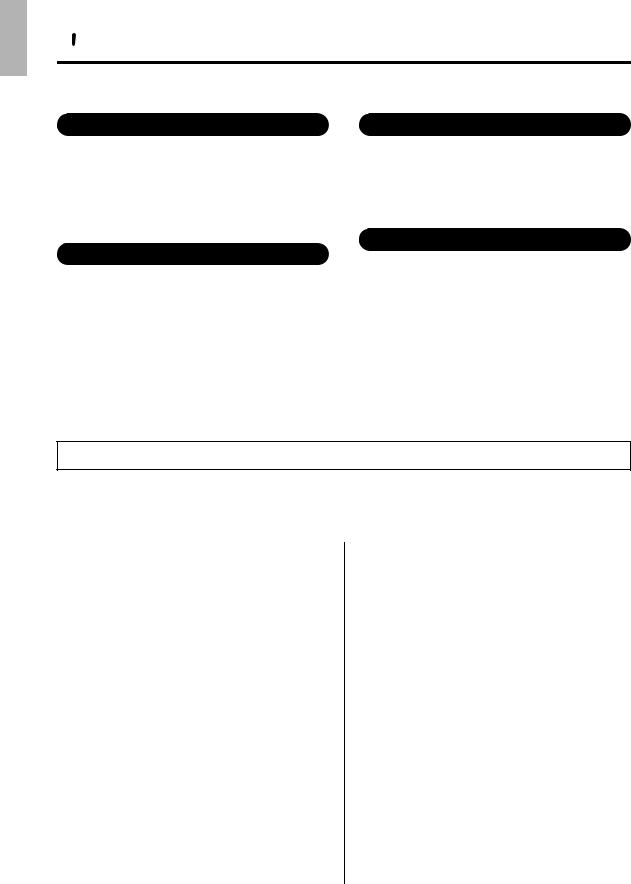
 CAUTION
CAUTION
Always follow the basic precautions listed below to avoid the possibility of physical injury to you or others, or damage to the instrument or other property. These precautions include, but are not limited to, the following:
Power supply/AC adaptor |
|
Connections |
•Do not connect the instrument to an electrical outlet using a multiple-connector. Doing so can result in lower sound quality, or possibly cause overheating in the outlet.
•When removing the electric plug from the instrument or an outlet, always hold the plug itself and not the cord. Pulling by the cord can damage it.
•Remove the electric plug from the outlet when the instrument is not to be used for extended periods of time, or during electrical storms.
•Before connecting the instrument to other electronic components, turn off the power for all components. Before turning the power on or off for all components, set all volume levels to minimum.
•Be sure to set the volumes of all components at their minimum levels and gradually raise the volume controls while playing the instrument to set the desired listening level.
Location
•Do not place the instrument in an unstable position where it might accidentally fall over.
•Before moving the instrument, remove all connected cables, to prevent damage to the cables or injury to anyone who might trip over them.
•When setting up the product, make sure that the AC outlet you are using is easily accessible. If some trouble or malfunction occurs, immediately turn off the power switch and disconnect the plug from the outlet. Even when the power switch is turned off, electricity is still flowing to the product at the minimum level. When you are not using the product for a long time, make sure to unplug the power cord from the wall AC outlet.
•Use only the stand specified for the instrument. When attaching it, use the provided screws only. Failure to do so could cause damage to the internal components or result in the instrument falling over.
Handling caution
•Do not insert a finger or hand in any gaps on the instrument.
•Never insert or drop paper, metallic, or other objects into the gaps on the panel or keyboard. This could cause physical injury to you or others, damage to the instrument or other property, or operational failure.
•Do not rest your weight on, or place heavy objects on the instrument, and do not use excessive force on the buttons, switches or connectors.
•Do not use the instrument/device or headphones for a long period of time at a high or uncomfortable volume level, since this can cause permanent hearing loss. If you experience any hearing loss or ringing in the ears, consult a physician.
Yamaha cannot be held responsible for damage caused by improper use or modifications to the instrument, or data that is lost or destroyed.
Always turn the power off when the instrument is not in use.
Even when the [  ] (Standby/On) switch is in standby status (power lamp is off), electricity is still flowing to the instrument at the minimum level. When you are not using the instrument for a long time, make sure you unplug the power cord from the wall AC outlet.
] (Standby/On) switch is in standby status (power lamp is off), electricity is still flowing to the instrument at the minimum level. When you are not using the instrument for a long time, make sure you unplug the power cord from the wall AC outlet.
NOTICE
To avoid the possibility of malfunction/ damage to the product, damage to data, or damage to other property, follow the notices below.
Handling
•Do not use the instrument in the vicinity of a TV, radio, stereo equipment, mobile phone, or other electric devices. Otherwise, the instrument, TV, or radio may generate noise. When you use the instrument along with an application on your iPad, iPhone or iPod touch, we recommend that you set “Airplane Mode” to “ON” on that device in order to avoid noise caused by communication.
•Do not expose the instrument to excessive dust or vibrations, or extreme cold or heat (such as in direct sunlight, near a heater, or in a car during the day) to prevent the possibility of panel disfiguration, damage to the internal components or unstable operation. (Verified operating temperature range: 5° – 40°C, or 41° – 104°F.)
•Do not place vinyl, plastic or rubber objects on the instrument, since this might discolor the panel or keyboard.
Maintenance
•When cleaning the instrument, use a soft and dry cloth. Do not use paint thinners, solvents, alcohol, cleaning fluids, or chemical-impregnated wiping cloths.
Saving data
•Some of the data of this instrument (page 24) are retained when the power is turned off. However, the saved data may be lost due to some failure, an operation mistake, etc. Save your important data onto an external device such as a computer (page 23).
DMI-5
Information
About copyrights
•Copying of the commercially available musical data including but not limited to MIDI data and/or audio data is strictly prohibited except for your personal use.
•This product incorporates and bundles contents in which Yamaha owns copyrights or with respect to which Yamaha has license to use others' copyrights. Due to copyright laws and other relevant laws, you are NOT allowed to distribute media in which these contents are saved or recorded and remain virtually the same or very similar to those in the product.
* The contents described above include a computer program, Accompaniment Style data,
MIDI data, WAVE data, voice recording data, a score, score data, etc.
*You are allowed to distribute medium in which your performance or music production using these contents is recorded, and the permission of Yamaha Corporation is not required in such cases.
About functions/data bundled with the instrument
• Some of the preset songs have been edited for length or arrangement, and may not be exactly the same as the original.
About this manual
•The illustrations as shown in this manual are for instructional purposes only, and may appear somewhat different from those on your instrument.
•iPhone, iPad and iPod touch are trademarks of Apple Inc., registered in the U.S. and other countries.
•The company names and product names in this manual are the trademarks or registered trademarks of their respective companies.
Tuning
•Unlike an acoustic piano, this instrument does not need to be tuned by an expert (although the pitch can be user-adjusted to match other instruments). This is because the pitch of digital instruments is always maintained perfectly.
2/2
6 P-125 Owner’s Manual
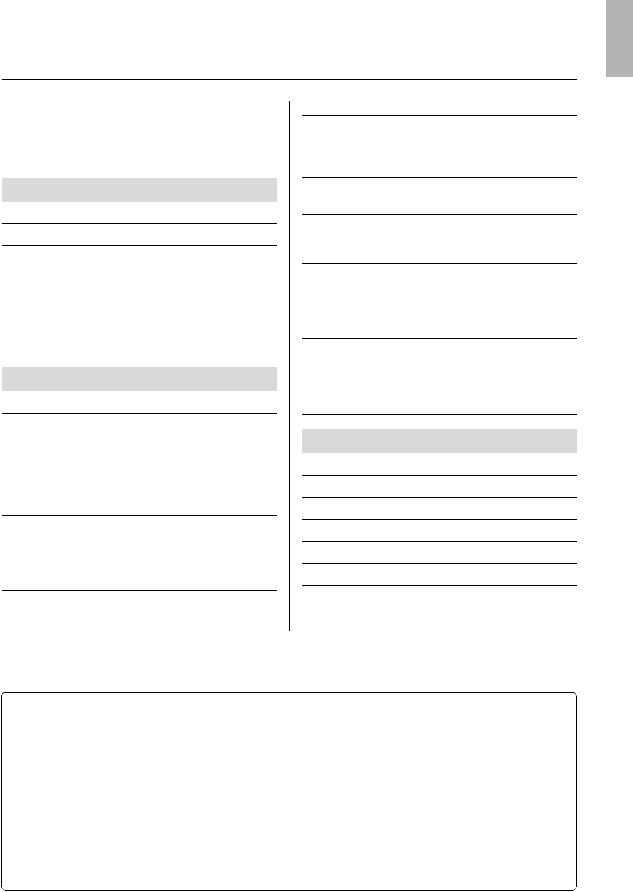
Contents
PRECAUTIONS ...................................................... |
5 |
With this instrument, you can:................................. |
7 |
About the Manuals .................................................. |
8 |
About the Key Operations....................................... |
8 |
Included Accessories .............................................. |
8 |
Introduction |
|
Panel Controls and Terminals |
9 |
Setting Up |
10 |
Power Requirements ............................................ |
10 |
Turning the Power On/Standby............................. |
10 |
Auto Power Off Function....................................... |
10 |
Adjusting the Master Volume ................................ |
11 |
Operation Confirmation Sounds............................ |
11 |
Using Headphones ............................................... |
11 |
Using a Pedal (Sustain) ........................................ |
12 |
Using the Optional Pedal Unit............................... |
12 |
Reference |
|
Selecting & Playing Voices |
13 |
Selecting a Voice .................................................. |
13 |
Using Table EQ..................................................... |
13 |
Strengthening the Overall Sound (Sound Boost).. |
13 |
Layering Two Voices (Dual).................................. |
14 |
Splitting the Keyboard (Split) ................................ |
15 |
Playing Duo........................................................... |
15 |
Using the Metronome |
16 |
Voice Confirmation of Current Tempo Value (in English).. |
16 |
Adjusting the Tempo ............................................. |
16 |
Selecting a Beat (Time Signature) ........................ |
16 |
Adjusting the Volume ............................................ |
16 |
Setting Various Items for Performances |
17 |
Tuning, Transpose ................................................ |
17 |
Reverb, Touch Sensitivity ..................................... |
17 |
Playing Back Songs |
18 |
Listening to the Voice Demo Songs ...................... |
18 |
Listening to the 50 Preset Songs or External Songs... |
18 |
Using Quick Play ................................................... |
19 |
Song Playback and Practice of Each Part |
19 |
Adding Accompaniment to Your Performance |
|
(Rhythm) |
20 |
Adjusting the Volume............................................. |
20 |
Adjusting the Tempo.............................................. |
20 |
Recording Your Performance |
21 |
Quick Recording .................................................... |
21 |
Recording Independently to Two Parts ................. |
21 |
Deleting the User Song ......................................... |
22 |
Changing the Initial Settings of the Recorded Song ... |
22 |
Connecting Other Equipment |
23 |
Connecting External Speakers .............................. |
23 |
Connecting an iPad or iPhone............................... |
23 |
Connecting to a Computer..................................... |
23 |
Playback/Recording of Audio Data (USB audio interface) .. |
24 |
Data Backup and Initializing |
24 |
Appendix |
|
Troubleshooting |
25 |
Specifications |
25 |
Voice List (Detailed) |
26 |
Index |
27 |
List |
28 |
Quick Operation Guide |
29 |
With this instrument, you can:
Enjoy the feel of an authentic piano action with the Graded Hammer Standard (GHS) keyboard.
Listen to the 50 Classics, or practice these preset songs by playing each part separately (pages 18 and 19).
Feel like a pro with the Rhythm feature that automatically adds accompaniment when you play the keyboard (page 20).
Practice effectively by using the built-in recorder and metronome (pages 16 and 21).
Enjoy easy operation by connecting your smart device. To use this, you'll need to install the “Smart Pianist” application (free for download; see page 23).
P-125 Owner’s Manual 7
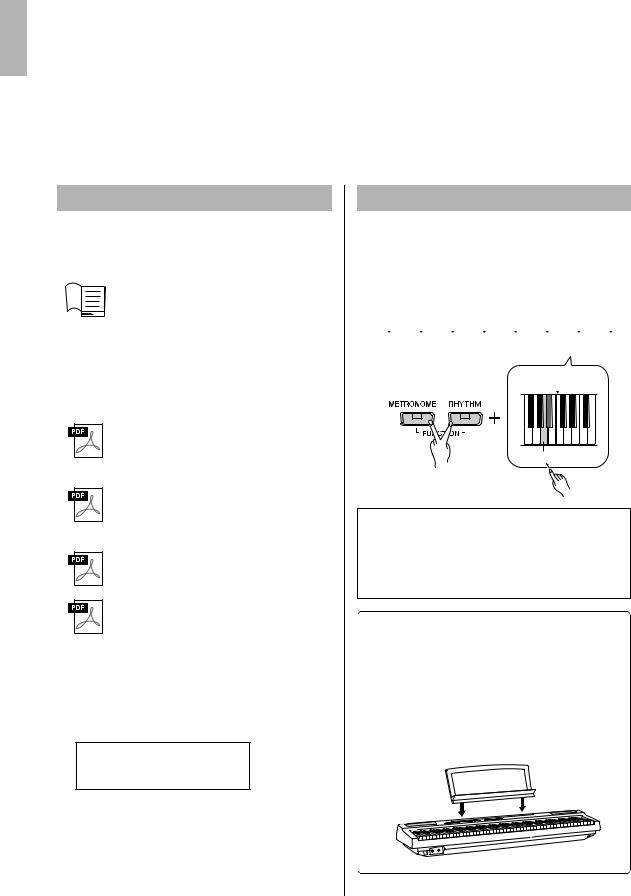
Thank you for purchasing this Yamaha Digital Piano!
This instrument provides exceptionally high-quality sound and expressive control for your playing enjoyment.
We recommend that you read this manual carefully so that you can fully take advantage of the advanced and convenient functions of the instrument.
We also recommend that you keep this manual in a safe and handy place for future reference.
About the Manuals
This instrument has the following documents and instructional materials.
Included Documents
Owner’s Manual (this book)
Quick Operation Guide (pages 29 to 31)
Shows in chart form the functions assigned to the buttons and the keyboard for quick understanding.
Online Materials (PDF)
iPhone/iPad Connection Manual
Explains how to connect the instrument to smart devices, such iPhone, iPad, etc.
Computer-related Operations
Contains instructions about computerrelated functions.
MIDI Reference
Contains MIDI-related information.
MIDI Basics (only in English, French, German and Spanish)
Contains basic explanations about what MIDI is and can do.
To obtain these materials, access the Yamaha Downloads website, then enter the model name for searching the desired files.
Yamaha Downloads
http://download.yamaha.com/
The letters at the end of the model name (“B” or “WH”) are color information of the instrument. For example, “B” indicates “black,” and “WH” indicates “white.” Since they simply indicate the color, these letters are omitted in this manual.
About the Key Operations
While holding down the button(s), press the appropriate key to make various settings, such as turning the function on or off, playing back the Songs and so on. If you come across the illustrations like below in this manual, press the same key while holding down the same button(s) as illustrated.
|
C0 |
|
|
|
|
C1 |
|
|
|
|
C2 |
|
|
|
|
C3 |
|
|
|
|
C4 |
|
|
|
|
C5 |
C6 |
|
|
|
|
C7 |
||||||||||||||||||
|
|
|
|
|
|
|
|
|
|
|
|
|
|
|
|
|
|
|
|
|
|
|
|
|
|
|
|
|
|
|
|
|
|
|
|
|
|
|
|
|
|
|
|
|
|
|
|
|
|
|
|
|
|
|
|
|
|
|
|
|
|
|
|
|
|
|
|
|
|
|
|
|
|
|
|
|
|
|
|
|
|
|
|
|
|
|
|
|
|
|
|
|
|
|
|
|
|
|
|
|
|
A#5: On
 C6
C6
A5: Off
q
While holding down
w
Above illustration indicates
qWhile simultaneously holding down the [METRONOME] and [RHYTHM] buttons…
wPress one of the shaded keys briefly. Finally, release all the buttons.
Included Accessories
•Owner’s Manual x1
•AC Adaptor* x1
•Warranty* x1
•Online Member Product Registration x1
•Footswitch x1
* May not be included depending on your particular area. Please check with your Yamaha dealer.
•Music Rest x1
Insert into the slot
8 P-125 Owner’s Manual
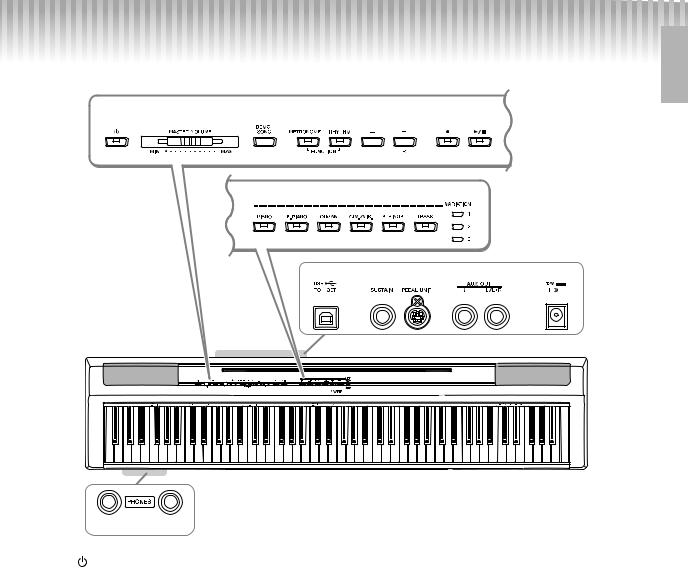
Panel Controls and Terminals
q |
w |
e r t y |
u i |
o
!0 |
!1!2 |
!3 |
!4 |
Shows the jacks and terminals as seen when viewed from the rear of the instrument.
A-1 |
C0 |
C1 |
C2 |
C3 |
C4 |
C5 |
C6 |
C7 |
!5
q [ ] (Standby/On) switch ...................... |
page 10 |
For turning the power on or setting to standby.
w [MASTER VOLUME] slider.................... |
page 11 |
For adjusting the volume of the entire sound.
e [DEMO/SONG] button ........................... |
page 18 |
For playing the Demo Songs and the Preset Songs.
r [METRONOME] button |
..........................page 16 |
For starting or stopping the metronome. |
|
t [RHYTHM] button ................................. |
page 20 |
For starting or stopping the rhythm. |
|
y [-][+], [L][R] buttons ........ |
pa g es 15 – 16, 18, 22 |
For selecting a Song during playback, adjusting the |
|
tempo, and selecting the Song part for recording |
|
and playback. |
|
u [] (Record) button .............................. |
page 21 |
For recording your keyboard performance. |
|
i [/] (Play/Stop) .................................. |
page 21 |
For playing back or stopping the recorded performance.
About the Built-in Speakers
Since sound from the built-in speakers also comes from the bottom of the instrument, we recommend that you use an optional keyboard stand for better sound. When playing the instrument placed on a desk or table, turn on the Table EQ function (page 13.)
o Voice buttons......................................... |
page 13 |
For selecting a Voice or two Voices played simulta- |
|
neously, such as Piano and Organ. |
|
!0[USB TO HOST] terminal ...................... |
page 23 |
For connecting to a computer or a smart device |
|
such as iPhone or iPad. |
|
!1[SUSTAIN] jack ...................................... |
page 12 |
For connecting the included footswitch, an |
|
optional footswitch and foot pedal. |
|
!2[PEDAL UNIT] jack ................................ |
page 12 |
For connecting an optional pedal unit. |
|
!3AUX OUT [R][L/L+R] jacks ................... |
page 23 |
For connecting external audio equipment. |
|
!4DC IN jack .............................................. |
page 10 |
For connecting the power adaptor. |
|
!5[PHONES] jacks .................................... |
page 11 |
For connecting a set of standard stereo headphones.
P-125 Owner’s Manual 9
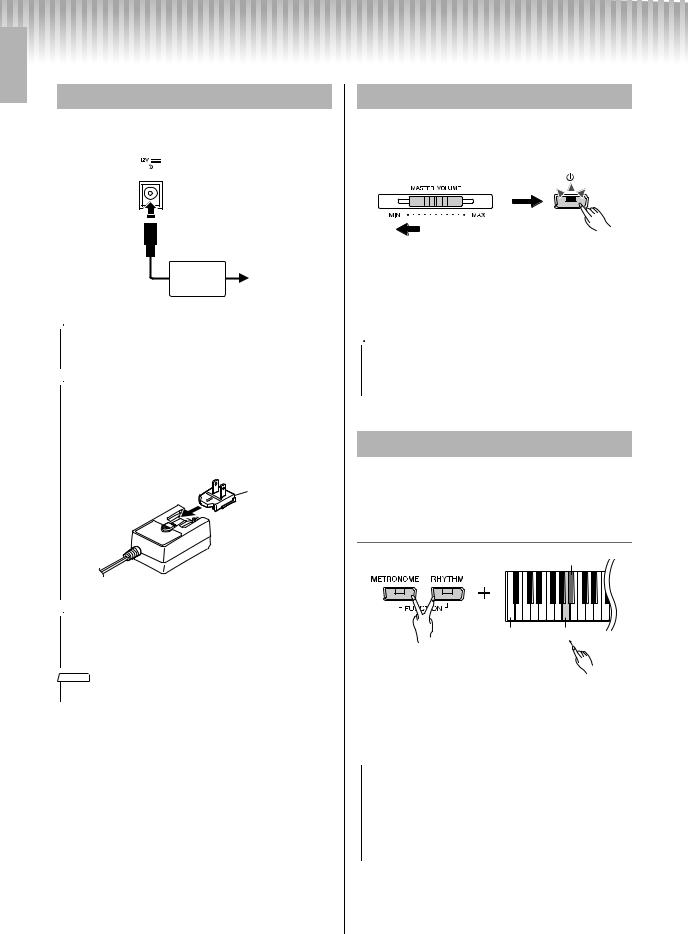
Setting Up
Power Requirements
Connect the AC adaptor in the order shown in the illustration.
DC IN jack (page 9)
q
w
AC adaptor |
AC outlet |
 WARNING
WARNING
•Use the specified AC adaptor (page 25) only. Using the wrong AC adaptor can result in damage to the instrument or overheating.
 WARNING
WARNING
•When using the AC adaptor with a removable plug, make sure to keep the plug attached to the AC adaptor. Using the plug alone can cause electric shock or fire.
•Never touch the metallic section when attaching the plug. To avoid electric shock, short circuit or damage, also be careful that there is no dust between the AC adaptor and plug.
Plug
Slide the plug as indicated.
* The shape of the plug differs depending on your area.
 CAUTION
CAUTION
•When setting up the product, make sure that the AC outlet you are using is easily accessible. If some trouble or malfunction occurs, immediately turn the power off and disconnect the plug from the outlet.
NOTE
• Follow the order shown above in reverse when disconnecting the AC adaptor.
Turning the Power On/Standby
qTurn down the [MASTER VOLUME] to “MIN”. wPress the [  ] (Standby/On) switch to turn the
] (Standby/On) switch to turn the
power on.
q |
w |
|
The [  ] (Standby/On) switch lights up. Adjust the volume as desired while playing the keyboard.
] (Standby/On) switch lights up. Adjust the volume as desired while playing the keyboard.
ePress and hold the [  ] (Standby/On) switch for about a second to turn the power to standby mode.
] (Standby/On) switch for about a second to turn the power to standby mode.
 CAUTION
CAUTION
•Even when the power switch is turned off, electricity is still flowing to the product at the minimum level. When you are not using the product for a long time, make sure to unplug the power cord from the wall AC outlet.
Auto Power Off Function
To prevent unnecessary power consumption, this function automatically turns the power off if the instrument is not operated for 30 minutes.
To disable/enable the Auto Power Off function
A#0: Enable
q |
Lowest |
A0: Disable |
key |
|
|
|
|
|
While holding |
|
|
down |
|
w |
When the power is off, turn the power on while holding down the lowest key disables Auto Power Off. The [REC] lamp flashes three times, indicating that the Auto Power Off function has been disabled.
NOTICE
•If your digital piano is connected to other equipment such as amplifiers, speakers, or a computer but you do not intend to use it for 30 minutes, we recommend that you turn off all devices as described in their owner’s manuals. Doing so eliminates the risk of damage to the other equipment. If you do not want the instrument to turn off automatically when connected to other equipment, disable the Auto Power Off function.
10 P-125 Owner’s Manual
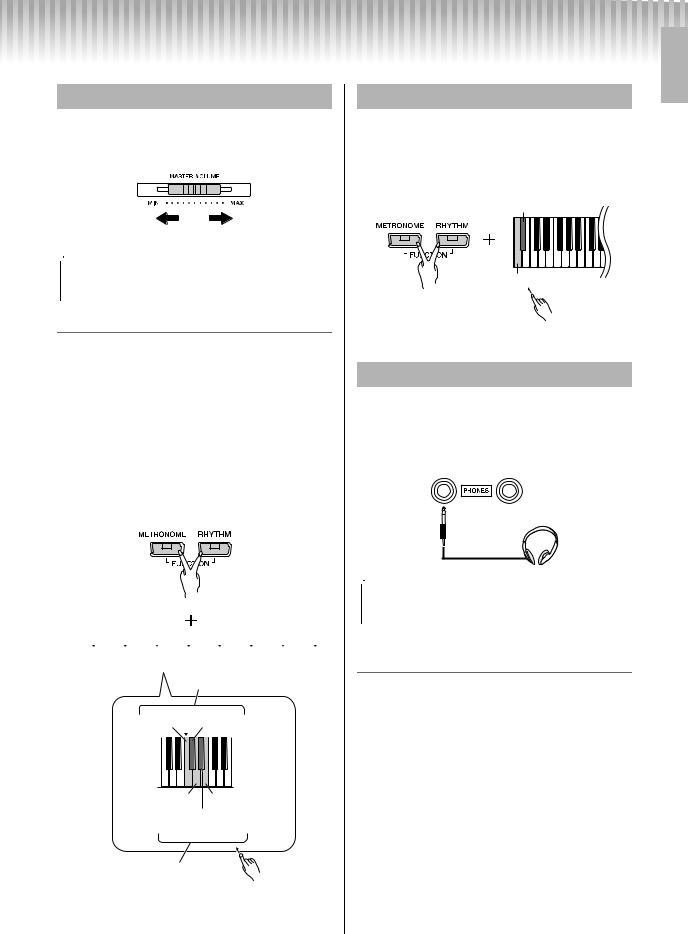
Adjusting the Master Volume
To adjust the volume of the entire keyboard sound, use the [MASTER VOLUME] while playing the keyboard.
Softer Louder
 CAUTION
CAUTION
•Do not use the instrument for a long period of time at a high or uncomfortable volume level, since this can cause permanent hearing loss.
Intelligent Acoustic Control (IAC)
With this function, the sound quality of this instrument is automatically adjusted and controlled according to the overall volume. Even when the volume is low, you can hear both low sounds and high sounds clearly. IAC Control is effective only from the sound output of the instrument speakers.
IAC On/Off
Default setting: on
IAC Depth
Setting range: -3 – 0 – +3
Default setting: 0
|
|
|
|
|
|
|
|
|
|
|
|
|
|
|
|
|
|
|
|
qWhile holding |
|
|
|
|
|
|
|
|
|
|
|
|
|
||||||||||||||
|
|
|
|
|
|
|
|
|
|
|
|
|
|
|
|
|
|
|
|
|
|
|
|
down |
|
|
|
|
|
|
|
|
|
|
|
|
|
|
|
|
|
|
|||||
|
C0 |
|
|
|
|
C1 |
|
|
|
|
C2 |
|
C3 |
|
|
|
|
C4 |
|
|
C5 |
|
|
|
|
C6 |
|
|
|
|
C7 |
||||||||||||||||
|
|
|
|
|
|
|
|
|
|
|
|
|
|
|
|
|
|
|
|
|
|
|
|
|
|
|
|
|
|
|
|
|
|
|
|
|
|
|
|
|
|
|
|
|
|
|
|
|
|
|
|
|
|
|
|
|
|
|
|
|
|
|
|
|
|
|
|
|
|
|
|
|
|
|
|
|
|
|
|
|
|
|
|
|
|
|
|
|
|
|
|
|
|
|
|
|
|
|
|
|
|
|
|
|
|
|
|
|
|
|
|
|
|
|
|
|
|
|
|
|
|
|
|
|
|
|
|
|
|
|
|
|
|
|
|
|
|
|
|
|
|
|
|
|
|
|
|
|
|
|
|
|
|
|
|
|
|
|
|
|
|
IAC On/Off |
|
|
|
|
|
|
|
|
|
|
|
|
|
|
|
|
|
|
|||||||||||
|
|
|
|
|
|
|
|
|
|
|
|
|
|
C2: Off |
C2 |
C#2: On |
|
|
|
|
|
|
|
|
|
|
|
|
|
|
|
|
|
|
|||||||||||||
|
|
|
|
|
|
|
|
|
|
|
|
|
|
|
|
|
|
|
|
|
|
|
|
|
|
|
|
|
|
|
|
|
|
|
|
|
|
|
|
|
|
|
|
||||
|
|
|
|
|
|
|
|
|
|
|
|
|
|
|
|
|
|
|
|
|
|
|
|
|
|
|
|
|
|
|
|
|
|
|
|
|
|
|
|
|
|
|
|
|
|
|
|
D2: Down by 1 E2: Up by 1
D#2: 0
(reset to the default setting)
IAC Depth |
w |
|
Setting Up
Operation Confirmation Sounds
When a setup is changed using a button and key combination, an operation sound (“On,” “Off,” click, tempo value input) is sounded. This confirmation sound can be enabled (On) or disabled (Off) as desired.
Second lowest key: On
Lowest key: Off
q
While holding |
w |
down |
Using Headphones
Connect a pair of headphones to the [PHONES] jack. Since this instrument is equipped with two [PHONES] jacks, you can connect two pairs of headphones. If you are using only one pair, insert the plug into either of these jacks.
Standard stereo phone plug
 CAUTION
CAUTION
•Do not use the headphones for a long period of time at a high or uncomfortable volume level, since this can cause permanent hearing loss.
Reproducing natural sound distance (Stereophonic Optimizer)
Default setting: on
The Stereophonic Optimizer recreate for headphones a natural distance between your ears and the instrument, just as when playing an acoustic piano.
Stereophonic Optimizer On/Off
While holding down [PIANO], press the F3 key to turn the function off or F#3 to turn on.
P-125 Owner’s Manual 11
